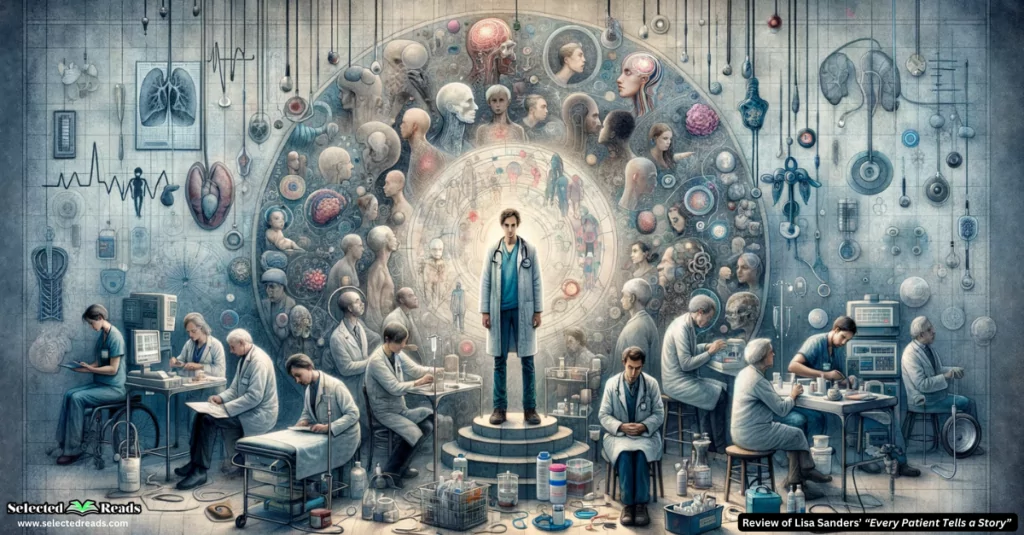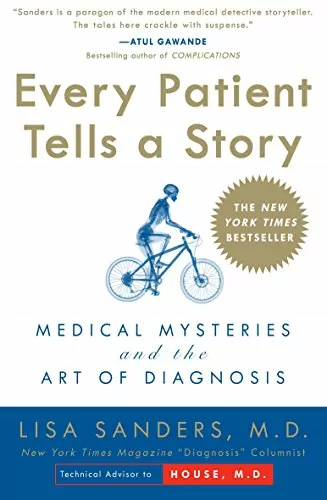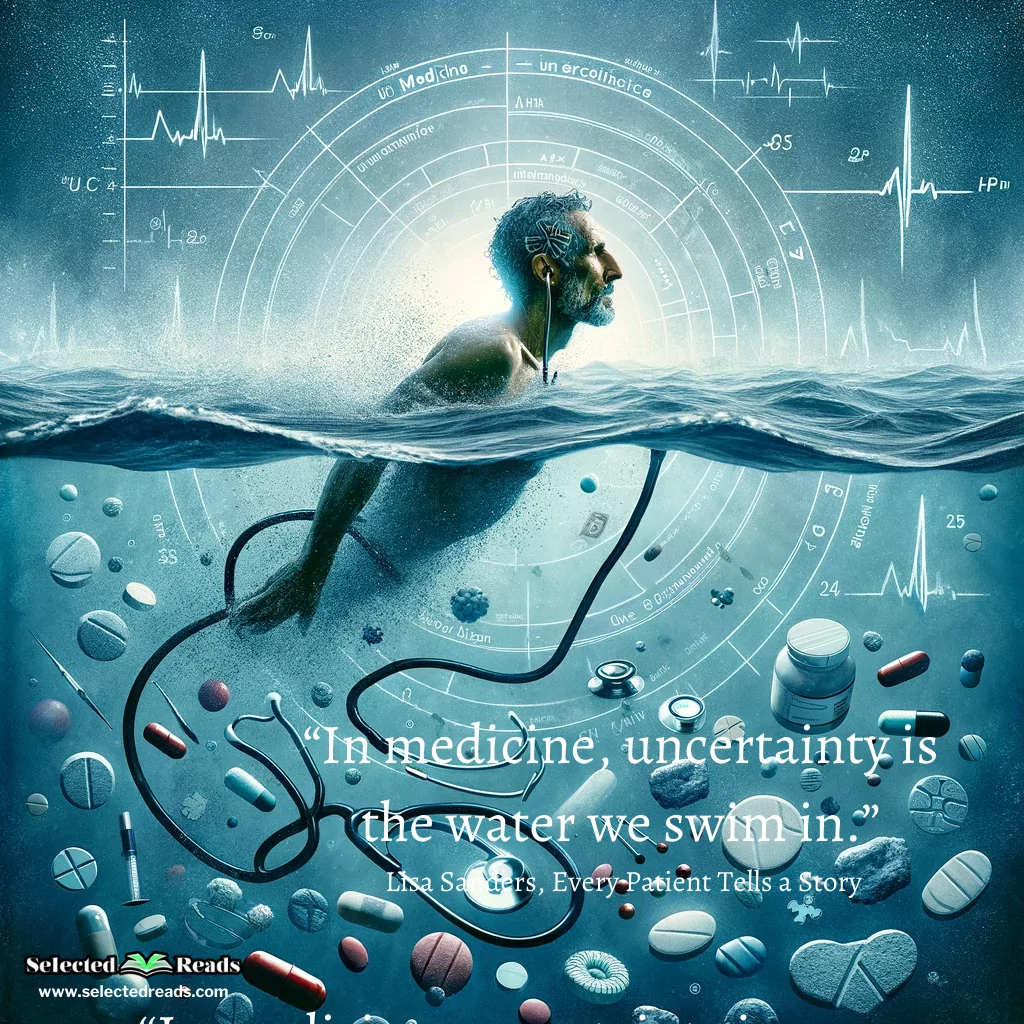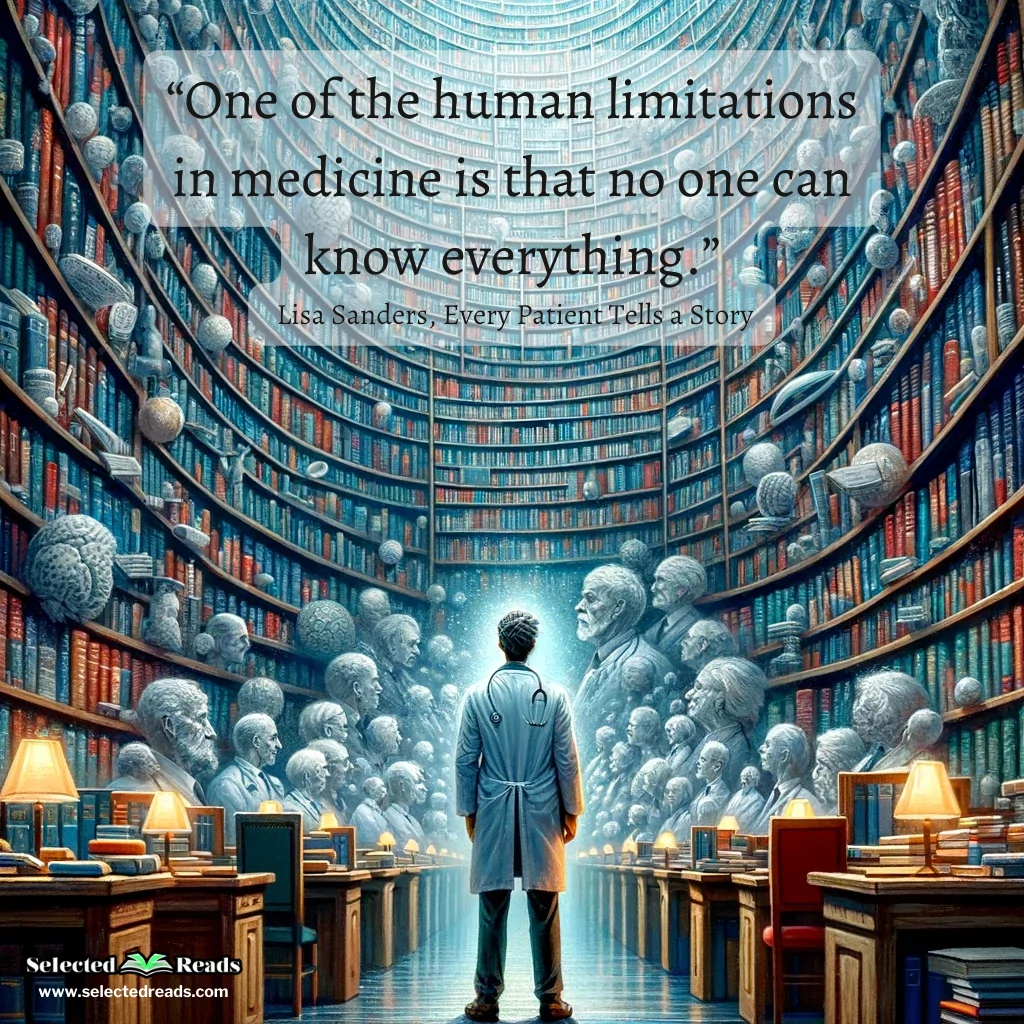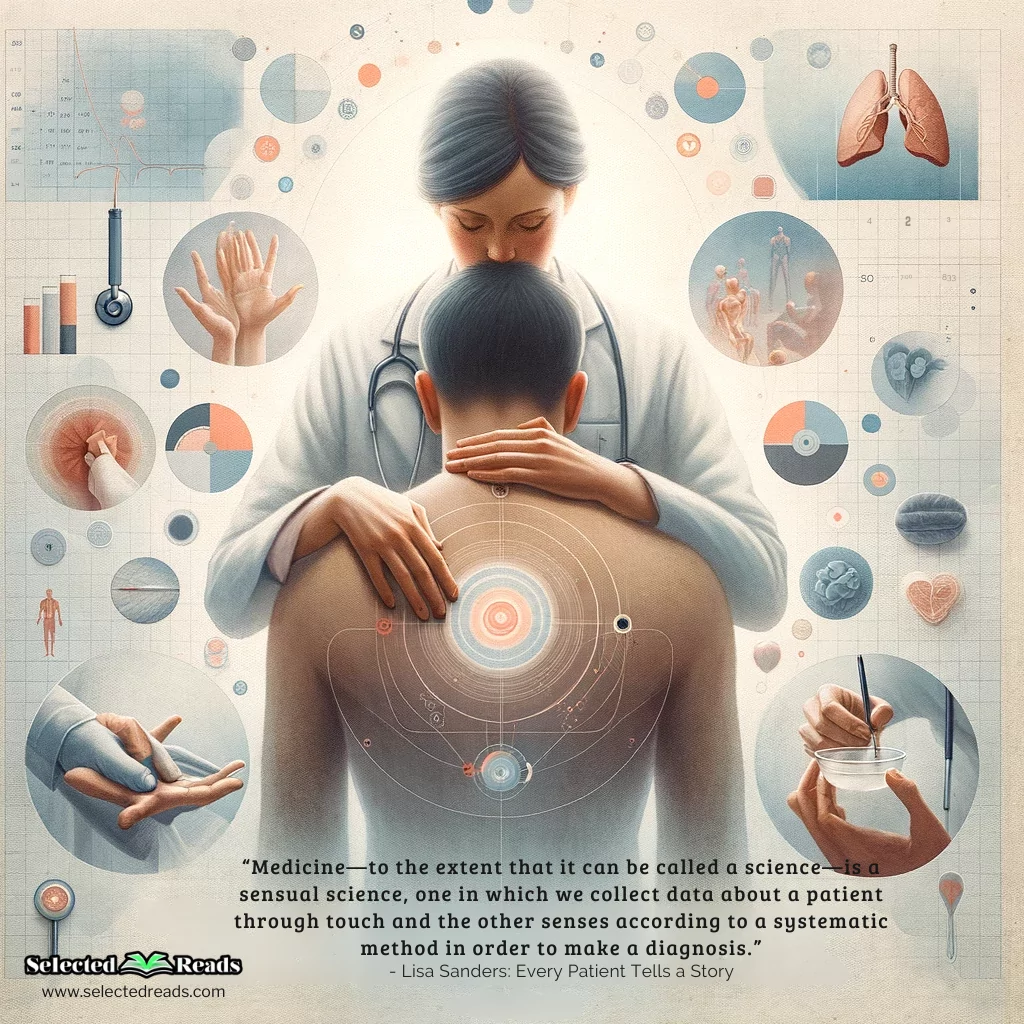In today’s post, we’ll dive into the captivating world of medical diagnosis as depicted in Lisa Sanders’ remarkable book, “Every Patient Tells a Story: Medical Mysteries and the Art of Diagnosis.” This exploration will not only offer an extended summary of the book but will also introduce you to the key characters that bring these stories to life.
We’ll also delve into some impactful quotes that resonate with the core themes of the book. To add an interactive and thought-provoking dimension, we’ll conclude with some intriguing book club questions designed to deepen your understanding and appreciation of this insightful work.
Every Patient Tells a Story Summary
“Every Patient Tells a Story: Medical Mysteries and the Art of Diagnosis,” authored by Dr. Lisa Sanders, is an intriguing exploration into the complexities of medical diagnosis. Dr. Sanders, a physician at Yale School of Medicine and the writer behind the New York Times Magazine column “Diagnosis,” offers a unique window into the challenges and intricacies of diagnosing illnesses, a theme that also inspired the TV series “House, M.D.”
In her book, Sanders takes readers on a journey through various perplexing medical cases. Each story is a puzzle, with patients presenting symptoms that often defy straightforward explanation. For instance, she describes a healthy young man who inexplicably loses his memory, unable to recall recent events.
Another case involves two patients who initially respond to Lyme disease treatment but then suffer a mysterious recurrence of symptoms. In a particularly harrowing account, Sanders recounts the story of a young woman fighting for her life in the ICU, displaying symptoms like bleeding, jaundice, and incoherence, leaving her doctors baffled about the cause.
These narratives are not just medical cases; they are profound human stories. They depict the vulnerability and fear experienced by patients suddenly thrust into the unknown world of illness. Sanders highlights how crucial a diagnosis is for these patients. It’s more than a medical term; it’s a tool that helps them understand their new reality and regain a sense of control, even when a cure is out of reach.
Sanders emphasizes that, despite the advancements in medical technology and knowledge, the process of diagnosis is fraught with challenges and uncertainties. Misdiagnoses occur, symptoms are misunderstood, and tests can be misleading. The book exposes the high stakes involved in diagnosing, where a single oversight or error can have dire consequences.
The book also delves into the importance of the patient’s narrative in reaching a diagnosis. Sanders underscores that listening to patients and understanding their stories is as crucial as any test or examination. This process, however, is laden with difficulties – from the nuances of doctor-patient communication to the limitations of physical exams and the complexities of interpreting tests.
“Every Patient Tells a Story” offers a candid look at the detective work inherent in diagnosing diseases. Sanders explores the blend of expertise, intuition, and sometimes guesswork that doctors rely on. Through her vivid storytelling, the book celebrates the art and science of diagnosis, highlighting its role in saving lives and restoring health.
This book is not just for medical professionals; it’s a compelling read for anyone fascinated by the mysteries of the human body and the process of medical investigation. It’s a reminder of the extraordinary skill and dedication of doctors, as well as the resilience and complexity of patients facing life-altering diagnoses.
Every Patient Tells a Story Characters
In “Every Patient Tells a Story,” the characters are primarily the patients and their medical conditions, along with the healthcare professionals involved in their diagnoses. Each patient’s story serves as a unique case study, illustrating various aspects of medical diagnosis. These stories bring to life the complexities of the human body and the challenges faced by doctors in deciphering symptoms to reach an accurate diagnosis.
Here are some key ‘character’ types featured in the book:
- Patients with Mysterious Illnesses: These are the central characters in each story. Their symptoms and medical histories are like puzzles that need to be solved. Each patient’s experience is unique, offering a personal perspective on illness and the healthcare system.
- Doctors and Medical Professionals: These characters are tasked with diagnosing the patients. They use a combination of medical knowledge, experience, and sometimes intuition to interpret symptoms and tests. The book highlights their challenges, successes, and sometimes failures in the diagnostic process.
- Medical Technology: While not a character in the traditional sense, medical technology plays a crucial role in many of the stories. From lab tests to imaging technology, these tools aid in the diagnostic process, sometimes providing crucial information, other times leading to more questions.
- Diseases and Conditions: Again, not traditional characters, but each medical condition featured in the book has its own ‘personality’ and set of challenges. They range from common ailments to rare and puzzling disorders, each posing different diagnostic challenges.
- Lisa Sanders (The Author): As the narrator, Sanders is a character herself, guiding the reader through each case. Her perspective as a physician and educator adds depth to the narratives, providing insights into the diagnostic process and the medical profession.
Every Patient Tells a Story Quotes
Here are some interesting quotes that capture the thematic essence of Every Patient Tells a Story:
- “In medicine, uncertainty is the water we swim in.” ― Lisa Sanders, Every Patient Tells a Story
- “A lot of the appeal of internal medicine is Sherlockian—solving the case from the clues. We are detectives; we revel in the process of figuring it all out. It’s what doctors most love to do.” ― Lisa Sanders, Every Patient Tells a Story
- “One of the human limitations in medicine is that no one can know everything.” ― Lisa Sanders, Every Patient Tells a Story
- “..I don’t count Jennifer among my mistakes. She had a severe infection and precious little reserve. Nevertheless, I think of her often. Those minutes of terror and confusion I felt standing powerless in her room served as a visceral reminder throughout my training… that the big picture isn’t enough in medicine…” ― Lisa Sanders, Every Patient Tells a Story
- “Despite all the available technology, the tools doctors often rely on most are the most old-fashioned—a phone, a respected colleague, a mentor or friend.” ― Lisa Sanders, Every Patient Tells a Story
- “If a doctor has worked through the problem well, there’s a very good chance that one of these possible diagnoses will be right. The rest though, by definition, will be wrong. We are regularly wrong in the pursuit of being right. … The question we are taught to ask ourselves is, if it isn’t that, what else could it be?” ― Lisa Sanders, Every Patient Tells a Story
- “Medicine—to the extent that it can be called a science—is a sensual science, one in which we collect data about a patient through touch and the other senses according to a systematic method in order to make a diagnosis.” ― Lisa Sanders, Every Patient Tells a Story
Book Club Questions
Here are some thought-provoking book club questions for the book “Every Patient Tells a Story”:
- How does Lisa Sanders highlight the importance of patient narratives in reaching a diagnosis? Can you recall a specific case from the book that emphasizes this?
- What is your perspective on the balance Sanders strikes between using advanced technology and maintaining the tradition of hands-on physical examination in diagnosis? Do you think one is more important than the other?
- Sanders stresses that often a diagnosis is all a doctor has to offer. What does this imply about the limitations of modern medicine, and how does this understanding affect your view of the medical profession?
- The author is both a doctor and has been a patient. How does this dual perspective influence her approach to diagnosing and understanding illness?
- The book underscores the art and science of medical diagnosis. Which case in the book do you think most vividly illustrates this balance?
- Sanders suggests that the ability to name an illness restores a sense of control to patients. Discuss the power and significance of naming and understanding illness as portrayed in the book.
- Consider the various medical mysteries discussed in the book. Which one intrigued you the most and why?
- How does “Every Patient Tells a Story” change your understanding of the patient-doctor relationship?
- Discuss how Sanders explores the gray areas of medicine, those cases where symptoms do not neatly fit into a textbook description. How does this aspect of medical practice contribute to the overall message of the book?
- In what ways does the book shed light on the process and challenges of medical diagnosis? How has reading this changed or confirmed your views about the healthcare system?
Final thoughts
In conclusion, “Every Patient Tells a Story” by Lisa Sanders is an exceptional book that sheds light on the mysteries of medicine and the human aspects of illness and diagnosis. Through detailed stories, insightful characters, and meaningful quotes, Sanders not only illuminates the challenges and complexities of diagnosing but also highlights the importance of empathy and understanding in the medical field.
The book club questions proposed are designed to spark deeper reflection and discussion, allowing readers to engage more fully with the themes of the book. Whether you’re a medical professional, a patient, or simply someone interested in the intricacies of health and illness, this book offers a compelling and enlightening journey into the heart of medical practice.



